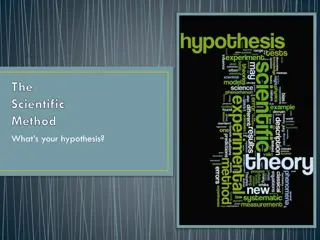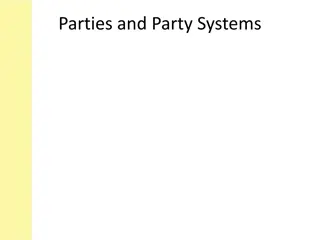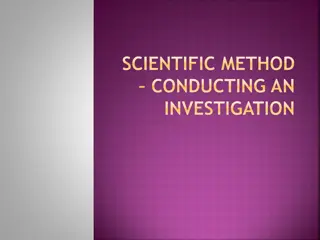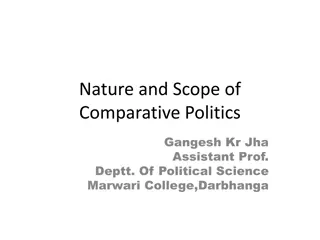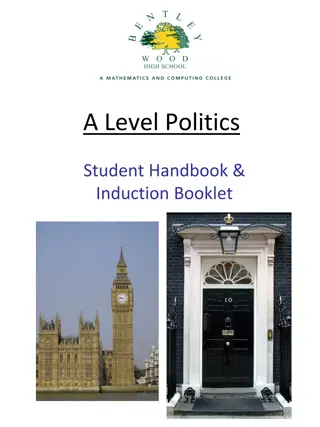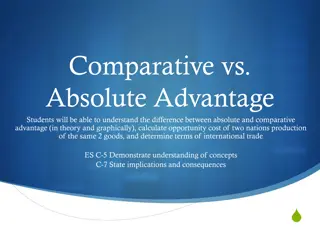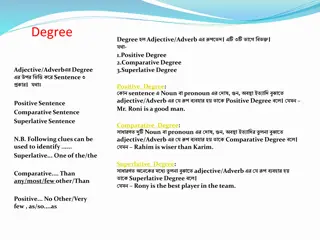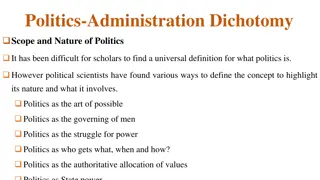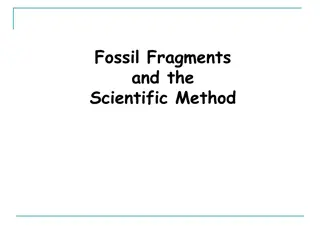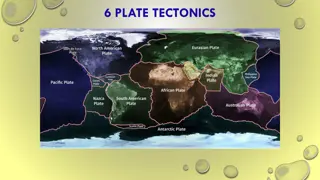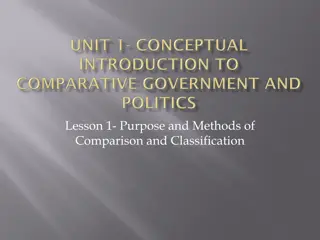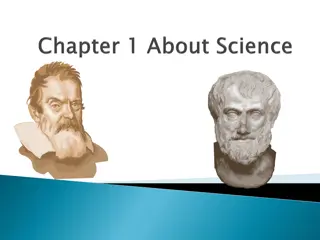Understanding the Scientific Method in Comparative Politics
Exploring the scientific method in political science and comparative politics reveals the systematic approach to acquiring knowledge through observation, hypothesis testing, and analysis of outcomes. Adherence to rules of inference is crucial for validity in scientific research, enabling researchers to study any phenomenon in a structured manner.
Download Presentation

Please find below an Image/Link to download the presentation.
The content on the website is provided AS IS for your information and personal use only. It may not be sold, licensed, or shared on other websites without obtaining consent from the author. Download presentation by click this link. If you encounter any issues during the download, it is possible that the publisher has removed the file from their server.
E N D
Presentation Transcript
Chapter 2: How to Study Comparative Politics: Using Comparative Methods OER materials provided with support from the Academic Senate for California Community Colleges (ASCCC) Open Educational Resources Initiative (OERI)
Chapter Outline Section #2.1: The Scientific Method and Comparative Politics Section #2.2: Four Approaches to Research Section #2.3: Case Selection (Or, How to Use Cases in Your Comparative Analysis)
Why Political Science is a Science? Scientific research has the four main characteristics Inference process of drawing a conclusion about an unobserved phenomenon, based on observed (empirical) information Procedures of scientific research must be public 1. 2. The conclusions of scientific research are uncertain as well The content of scientific research is the method 3. 4.
2.1 The Scientific Method and Comparative Politics Science is defined as the systematic and organized approach to any area of inquiry and utilizes scientific methods to acquire and build a body of knowledge Political science, as well as comparative politics as a subfield of political science, embody the essence of the scientific method and possess deep foundations for the scientific tools and theory formation which align with their areas of inquiry Scientific research must adhere to a set of rules of inference because its validity is dependent on how closely one follows such rules and procedures Simply put, one can virtually study anything in a scientific manner as long as the researcher follows the rules of inference and scientific methods
2.1.2 The Scientific Method The scientific method is a process by which knowledge is acquired through a sequence of steps, which generally include the following components: Question Observation Hypothesis Testing of the hypothesis Analysis of the outcomes Reporting of the findings
Image 2.1.2: Scientific Method in Political Science, Illustrated Illustration of the steps of the scientific method in political science. (Source: Author's Creation.)
2.1.2 The Scientific Method: The Research Question Develop a clear, focused and relevant research question Although this sounds like a simple step, there is complexity of forming a sound research question A research question must be falsifiable: Able to be logically contradicted through empirical testing Non-falsifiable The question cannot be proven true or false under present circumstances, particularly questions which are subjective Empirical analysis: Defined as being based on experiment, experience or observation
2.1.2 The Scientific Method: Literature Review Research the context and background information and previous research regarding this research question A literature review becomes a section of your research paper or research process which collects key sources and previous research on your research question and discusses the findings in synthesis with each other From this work, you are able to have a full scope of understanding of all previous work performed on your topic, which will enhance knowledge in the field.
2.1.2 The Scientific Method: Theory and Hypothesis Development Develop a theory that explains a potential answer to your research question A theory is a statement that explains how the world works based on the experiences and observation Consists of a set of assumptions, hypotheses, and independent (explanatory) and dependent (outcome) variables Assumptions are statements that are taken for granted
2.1.2 The Scientific Method: Theory and Hypothesis Development A hypothesis is a specific and testable prediction of what you think will happen A hypothesis, or set of hypotheses, will describe, in very clear terms, what you expect will happen given the circumstances Inductive reasoning Scientists look at specific situations and attempt to form a hypothesis Deductive reasoning Make an inference and then test its truth using evidence and observations
2.1.2 The Scientific Method: Theory and Hypothesis Development A variable is a factor or object that can vary or change. As political scientists are concerned with cause-and-effect relationships, they will divide the variables into two categories: Independent variables (a.k.a. Explanatory variables) are the cause, and these variables are independent of other variables under consideration in a study Dependent variables (a.k.a. Outcome variables) are the assumed effect, their values will (presumably) depend on the changes in the independent variables
2.1.2 The Scientific Method: Testing & Analysis A political scientist, at this stage, will test the hypothesis, or hypotheses, through observation of the relationship between the designated variables When the testing is complete, political scientists will need to review their results and draw conclusions about the findings Was the hypothesis correct? If so, they will be able to report out the success of their findings Was the hypothesis incorrect? That s okay! A famous quip in this field is, No finding is still a finding If the hypothesis was not proven true, or fully true, then it s back to the drawing board to rethink a new hypothesis and do the testing again
2.1.2 The Scientific Method: Reporting of Findings Reporting results, whether the hypothesis is true, partially true, or outright false, is critical to the advancement of the overall field Not all research will result in publication, though publication is often the goal of research Typically, researchers will attempt to publish their findings in a public and transparent manner Others may continue research in that area
2.2 Four Approaches to Research 1. Experimental Method 2. Statistical Methods 3. The Comparative Method 4. Case Studies
2.2.1: The Experimental Method An experiment is defined as laboratory studies in which investigators retain control over the recruitment, assignment to random conditions, treatment, and measurement of subjects An experiment is used whenever the researcher seeks to answer causal questions or is looking for causal inference. A causal question involves discerning cause and effect, also referred to as a causal relationship Experimental methods in political science almost always involve statistical tools to discern causality, which will be discussed next
Correlation v. Causation Correlation does not equal causation! Causation vs. Correlation Variable X Variable y Variable X Variable y On the left, we see that Variable X causes Variable Y, which is referred to as causation On the right, we see that Variable X is related to Variable Y, which is referred to as correlation When X is present, so is Y. Conversely, when Y is present, so is X. The two variables go hand in hand.
2.2.2: Statistical Methods Statistical methods are the use of mathematical techniques to analyze collected data, usually in numerical form, such as interval or ratio-scale Statistical methods are also the preferred approach when it comes to the analysis of survey data. Survey research involves the examination of a sample derived from a larger population Applied research is defined as research that attempts to explain social phenomena with immediate public policy implications"
2.2.3: The Comparative Method Comparative methods involve the analysis of a small number of cases, entailing at least two observations Comparison is more than just description, it involves conceptualizing A concept is defined as an abstract or generic idea generalized from particular instances Concepts are generally seen as nonmathematical and deal with substantive issues The comparative method involves more than a case study, or single- N research but less than a statistical analysis, or large-N study
Large-N Statistical Methods Experimental Methods Scientific Methods Comparing the three empirical research approaches Intermediate-N Comparative Methods Non- Experimental Methods Single-N Case Studies
2.2.4: Case Studies Comparative case study Defined as a study that is structured on the comparison of two or more cases Subnational case study When subnational governments, such provincial governments, regional governments, and other local governments often referred to as municipalities, are the cases that are researched and/or compared Case studies are vital to theory development in political science They are the cornerstones of different discourses in the discipline Cases in comparative politics have historically focused on the nation- state Researchers compare countries
2.2.4: Case Studies Case studies are one of major techniques used by comparativists to study phenomena Cases provide for the in-depth traditional research Many times, there is a gap in knowledge, or a research question that necessitates a certain level of detail A case is defined as a spatially delimited phenomenon (a unit) observed at a single point in time, or over some period of time A case study is an intensive look into that single case, often with the intent that this single case may help us better understand a particular variable of interest. Cross-case and sub-national case study research
2.3: Case Selection (Or, How to Use Cases in Your Comparative Analysis) Deciding how many cases, and which cases, to include, will clearly help determine the outcome of our results Large-N research When the number of observations or cases is large enough where we would need mathematical, usually statistical, techniques to discover and interpret any correlations or causations Randomization: Make sure the sample is representative to reduce bias When it comes to comparative politics, we rarely ever reach the numbers typically used in large-N research
2.3: Case Selection (Or, How to Use Cases in Your Comparative Analysis) In small-N research, case selection simply matters much more Case selection can be driven by a number of factors in comparative politics Can derive from the interests of the researcher(s) Case selection may be driven by area studies Selection of cases selected may be driven by the type of case study that is utilized In this approach, cases are selected as they allow researchers to compare their similarities or their differences Or, a case might be selected that is typical of most cases, or in contrast, a case or cases that deviate from the norm
2.3: Types of Case Studies Descriptive Case Studies are not organized around a central, overarching causal hypothesis or theory Most case studies are descriptive in nature, where the researchers simply seek to describe what they observe They are useful for transmitting information regarding the studied political phenomenon Causal Case Studies are organized around a central hypothesis about how X affects Y In causal case studies, the context around a specific political phenomenon or phenomena is important as it allows for researchers to identify the aspects that set up the conditions, the mechanisms, for that outcome to occur Causal mechanism Portable concepts that explain how and why a hypothesized cause, in a given context, contributes to a particular outcome
2.3.2 Most Similar / Most Different Systems Approach Method of Agreement In the method of agreement two or more cases are compared for their commonalities. The scholar looks to isolate the characteristic, or variable, they have in common, which is then established as the cause for their similarities. Method of Difference In the method of difference two or more cases are compared for their differences. The scholar looks to isolate the characteristic, or variable, they do not have in common, which is then identified as the cause for their differences
2.3.2 Most Similar / Most Different Systems Approach Method of Agreement Most Different Systems Design (MDSD) This approach is derived from Mill s method of agreement In a most different systems approach we are interested in selecting cases that are quite different from one another, yet arrive at the same outcome Method of Difference Most Similar Systems Design (MSSD) This approach is derived from Mill s method of difference . In a most similar systems approach we are interested in keeping as many of the variables the same across the elected cases, which for comparative politics often involves countries
Summary Comparative politics is a social science which follows the scientific method as a way to advance knowledge in the field 1. To this end, the scientific method is a process by which knowledge is acquired through a sequence of steps: Question, observation, hypothesis, testing of the hypothesis, analysis of the outcomes, and reporting of the findings There are four basic approaches used in empirical research 2. Experimental method, Statistical method, Case study methods, Comparative method
Summary Case studies are one of major techniques used by comparativists to study various phenomena A case study is an intensive look into a single case, often with the intent that this single case may help us better understand a particular variable of interest 3. For Case Selection, comparativists have utilized John Stuart Mill s approaches of Most Similar System Design (MSSD) and Most Different System Design (MDSD) 4. In a Most Similar Systems Design approach, the cases selected are similar to each other, but result in different outcomes Conversely, in a Most Different System Design, the cases selected are different from each other, but result in the same outcome





